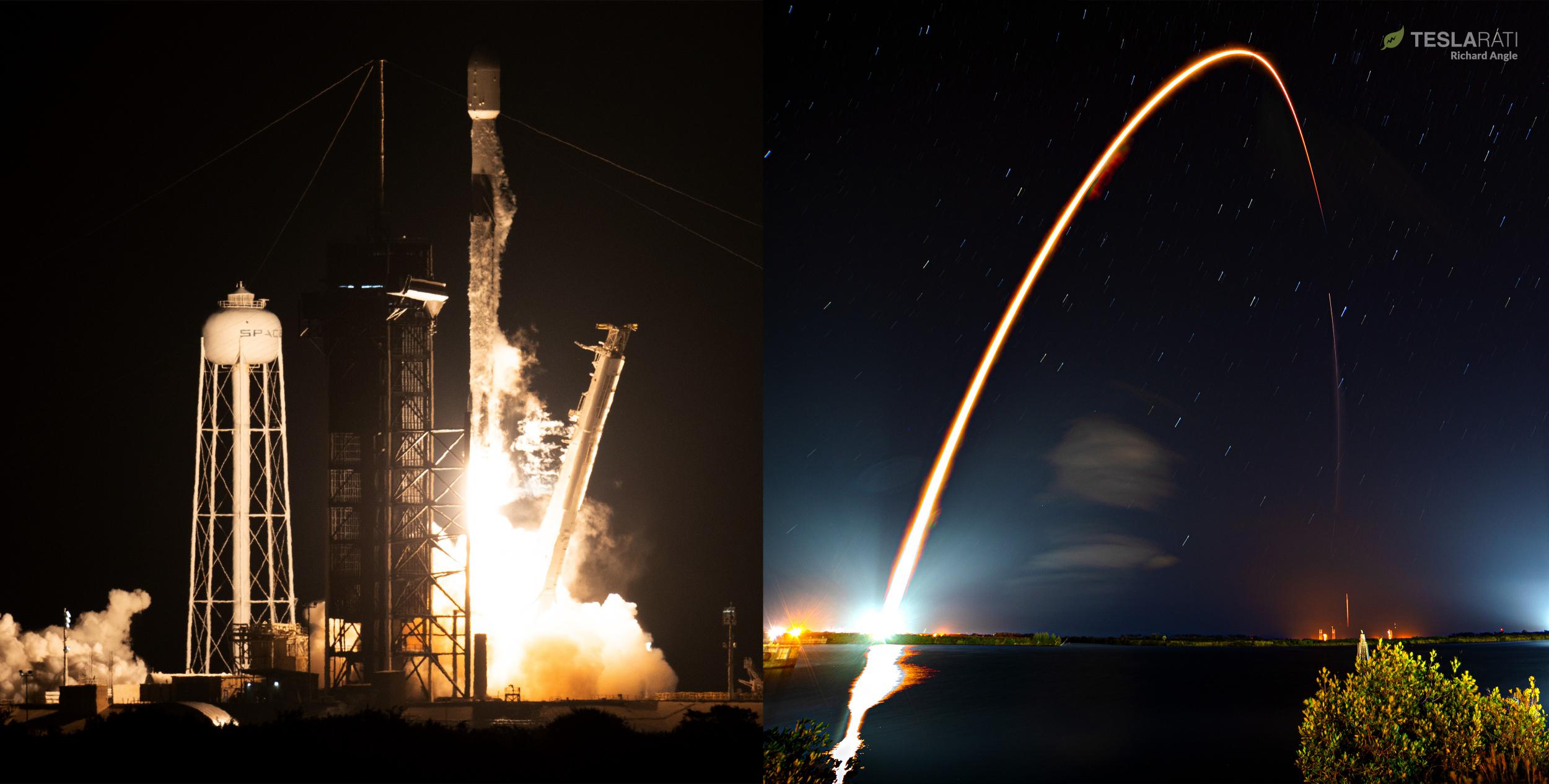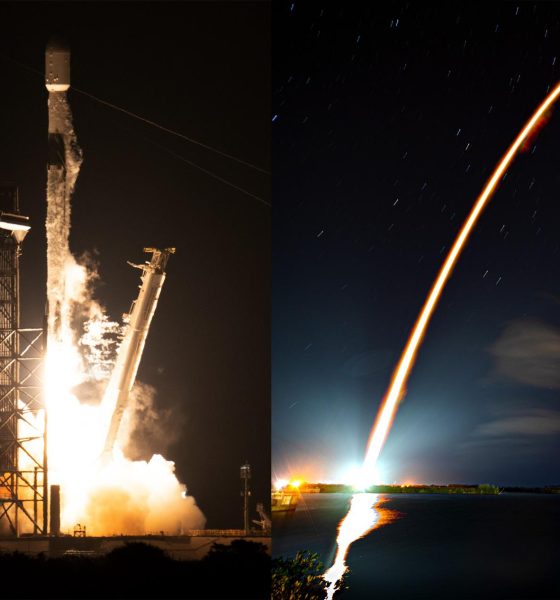

News
SpaceX launches NASA mission to study black holes, dead stars, and more
SpaceX has successfully launched NASA’s Imaging X-ray Polarimetry Explorer telescope, paving the way for a unique aspect of black holes, a variety of dead stars, and other odd phenomena to be explored in unprecedented breadth and detail.
Marking the first time a NASA payload has launched on the fifth flight of a reused SpaceX rocket, Falcon 9 booster B1061 lifted off at 1am EST (06:00 UTC) to kick off the 330 kg (~730 lb) IXPE spacecraft’s journey to orbit. SpaceX’s workhorse rocket performed flawlessly. Just over eight minutes after liftoff, Falcon 9’s upper stage completed the first of two planned burns, entering a low parking orbit. About thirty seconds later, Falcon 9 B1061 stuck its fifth drone ship landing in 13 months, marking the end of another successful high-profile launch for the booster and ensuring that it will be able to complete many more such launches over the next few years.

The first portion of the launch completed, Falcon 9’s upper stage then coasted in orbit for about 20 minutes before ignited for one last (very expensive) burn to place IXPE in its desired orbit. Known as a plane or inclination change, the maneuver – especially when performed deep in a large gravitational well – is exceptionally expensive, requiring an unintuitively large amount of launch vehicle performance (known as delta-V). The reason: IXPE’s nominal orbit is almost exactly equatorial, which Falcon 9’s Cape Canaveral launch site is about 28.5 degrees north of.
Lowering that inclination after launch requires a very energetic maneuver. Before Falcon 9 beat it out for the launch contract, IXPE was expected to launch on Orbital ATK’s air-launched Pegasus XL rocket, which would have allowed IXPE to be launched at the equator. However, SpaceX ultimately submitted a bid to launch IXPE for just ~$50M – cheaper than its competitor despite the fact that Falcon 9 is more than 20 times larger and could potentially launch an entire Pegasus XL into orbit. However, while Falcon 9 is designed to launch almost 23 tons into orbit in an expendable configuration and more than 16 tons with booster and fairing recovery, it’s only capable of launching about 1-2 tons to IXPE’s desired combination of an equatorial inclination and a ~600 km (~370 mi) orbit.
Ultimately, Falcon 9 completed the inclination change without issue, marking the successful completion of its first equatorial launch ever and SpaceX’s 28th successful launch in 2021 alone. Unlike a significant majority of spacecraft, IXPE was launched directly into its operational orbit and will likely need just a few days to refine its position and a few weeks after that for ground controllers to verify the health of all its systems and deploy a 4m (`13 ft) long ‘boom’ needed to operate its unique telescope.
If or when everything is up and running, IXPE will spend a minimum of two years observing at least 50 of the weirdest objects and phenomena in the universe. While many of those objects can’t be directly imaged, IXPE’s goal is to analyze the polarization of X-rays – high-energy beams of radiation – they produce at sensitivities two orders of magnitude greater than any previous experiment. In theory, that should allow IXPE to put long-held laws of relativity and quantum physics to the test in some of the most extreme environments in the universe, including particularly exotic nebulae (giant gas clouds), black holes, and bizarre neutron stars (including lighthouse-like pulsars and magnetars – dead stars with magnetic fields strong enough to compress atoms into cylindrical rods and make the actual vacuum of space refract light like a crystal).

News
Tesla FSD fleet is nearing 7 billion total miles, including 2.5 billion city miles
As can be seen on Tesla’s official FSD webpage, vehicles equipped with the system have now navigated over 6.99 billion miles.

Tesla’s Full Self-Driving (Supervised) fleet is closing in on almost 7 billion total miles driven, as per data posted by the company on its official FSD webpage.
These figures hint at the massive scale of data fueling Tesla’s rapid FSD improvements, which have been quite notable as of late.
FSD mileage milestones
As can be seen on Tesla’s official FSD webpage, vehicles equipped with the system have now navigated over 6.99 billion miles. Tesla owner and avid FSD tester Whole Mars Catalog also shared a screenshot indicating that from the nearly 7 billion miles traveled by the FSD fleet, more than 2.5 billion miles were driven inside cities.
City miles are particularly valuable for complex urban scenarios like unprotected turns, pedestrian interactions, and traffic lights. This is also the difference-maker for FSD, as only complex solutions, such as Waymo’s self-driving taxis, operate similarly on inner-city streets. And even then, incidents such as the San Francisco blackouts have proven challenging for sensor-rich vehicles like Waymos.
Tesla’s data edge
Tesla has a number of advantages in the autonomous vehicle sector, one of which is the size of its fleet and the number of vehicles training FSD on real-world roads. Tesla’s nearly 7 billion FSD miles then allow the company to roll out updates that make its vehicles behave like they are being driven by experienced drivers, even if they are operating on their own.
So notable are Tesla’s improvements to FSD that NVIDIA Director of Robotics Jim Fan, after experiencing FSD v14, noted that the system is the first AI that passes what he described as a “Physical Turing Test.”
“Despite knowing exactly how robot learning works, I still find it magical watching the steering wheel turn by itself. First it feels surreal, next it becomes routine. Then, like the smartphone, taking it away actively hurts. This is how humanity gets rewired and glued to god-like technologies,” Fan wrote in a post on X.
News
Tesla starts showing how FSD will change lives in Europe
Local officials tested the system on narrow country roads and were impressed by FSD’s smooth, human-like driving, with some calling the service a game-changer for everyday life in areas that are far from urban centers.

Tesla has launched Europe’s first public shuttle service using Full Self-Driving (Supervised) in the rural Eifelkreis Bitburg-Prüm region of Germany, demonstrating how the technology can restore independence and mobility for people who struggle with limited transport options.
Local officials tested the system on narrow country roads and were impressed by FSD’s smooth, human-like driving, with some calling the service a game-changer for everyday life in areas that are far from urban centers.
Officials see real impact on rural residents
Arzfeld Mayor Johannes Kuhl and District Administrator Andreas Kruppert personally tested the Tesla shuttle service. This allowed them to see just how well FSD navigated winding lanes and rural roads confidently. Kruppert said, “Autonomous driving sounds like science fiction to many, but we simply see here that it works totally well in rural regions too.” Kuhl, for his part, also noted that FSD “feels like a very experienced driver.”
The pilot complements the area’s “Citizen Bus” program, which provides on-demand rides for elderly residents who can no longer drive themselves. Tesla Europe shared a video of a demonstration of the service, highlighting how FSD gives people their freedom back, even in places where public transport is not as prevalent.
What the Ministry for Economic Affairs and Transport says
Rhineland-Palatinate’s Minister Daniela Schmitt supported the project, praising the collaboration that made this “first of its kind in Europe” possible. As per the ministry, the rural rollout for the service shows FSD’s potential beyond major cities, and it delivers tangible benefits like grocery runs, doctor visits, and social connections for isolated residents.
“Reliable and flexible mobility is especially vital in rural areas. With the launch of a shuttle service using self-driving vehicles (FSD supervised) by Tesla in the Eifelkreis Bitburg-Prüm, an innovative pilot project is now getting underway that complements local community bus services. It is the first project of its kind in Europe.
“The result is a real gain for rural mobility: greater accessibility, more flexibility and tangible benefits for everyday life. A strong signal for innovation, cooperation and future-oriented mobility beyond urban centers,” the ministry wrote in a LinkedIn post.
News
Tesla China quietly posts Robotaxi-related job listing
Tesla China is currently seeking a Low Voltage Electrical Engineer to work on circuit board design for the company’s autonomous vehicles.

Tesla has posted a new job listing in Shanghai explicitly tied to its Robotaxi program, fueling speculation that the company is preparing to launch its dedicated autonomous ride-hailing service in China.
As noted in the listing, Tesla China is currently seeking a Low Voltage Electrical Engineer to work on circuit board design for the company’s autonomous vehicles.
Robotaxi-specific role
The listing, which was shared on social media platform X by industry watcher @tslaming, suggested that Tesla China is looking to fill the role urgently. The job listing itself specifically mentions that the person hired for the role will be working on the Low Voltage Hardware team, which would design the circuit boards that would serve as the nervous system of the Robotaxi.
Key tasks for the role, as indicated in the job listing, include collaboration with PCB layout, firmware, mechanical, program management, and validation teams, among other responsibilities. The role is based in Shanghai.
China Robotaxi launch
China represents a massive potential market for robotaxis, with its dense urban centers and supportive policies in select cities. Tesla has limited permission to roll out FSD in the country, though despite this, its vehicles have been hailed as among the best in the market when it comes to autonomous features. So far, at least, it appears that China supports Tesla’s FSD and Robotaxi rollout.
This was hinted at in November, when Tesla brought the Cybercab to the 8th China International Import Expo (CIIE) in Shanghai, marking the first time that the autonomous two-seater was brought to the Asia-Pacific region. The vehicle, despite not having a release date in China, received a significant amount of interest among the event’s attendees.








